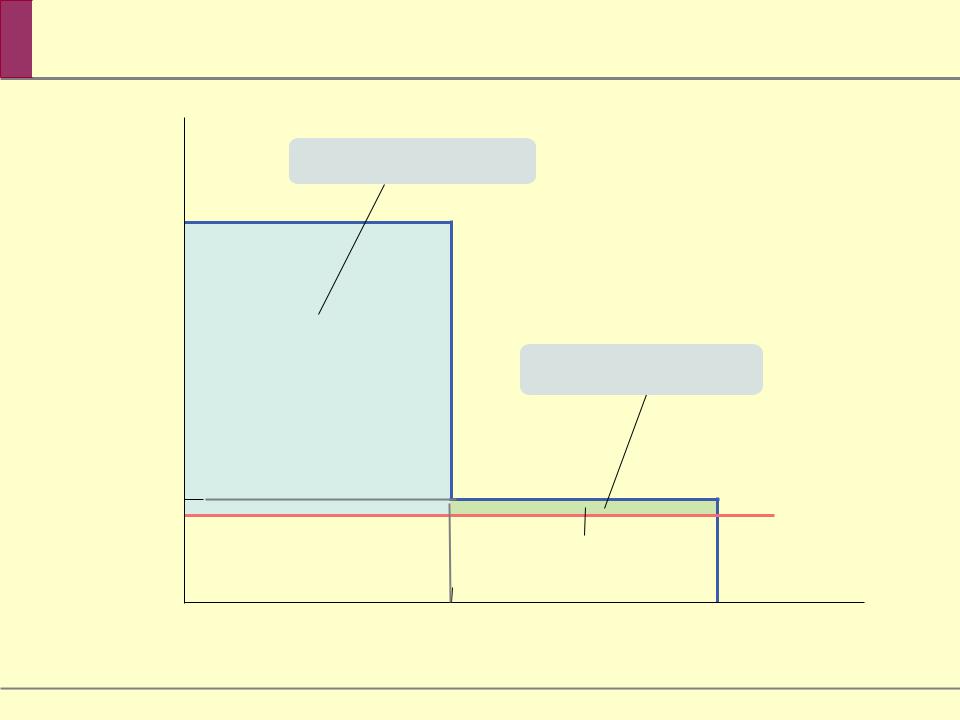
Lectures_micro / Microeconomics_presentation_Chapter_14
.pdf
Competition |
Price, |
cost |
Consumer surplus with |
perfect competition |
D |
Quantity |
Price, cost, |
|
marginal |
Consumer surplus |
revenue |
|
|
with monopoly |
|
Pro"t |
|
Deadweight |
|
loss |


 Preventing Monopoly
Preventing Monopoly
Breaking up a monopoly that isn’t natural is clearly a good idea, but it’s not so clear whether a natural monopoly, one in which large producers have lower average total costs than small producers, should be broken up, because this would raise average total cost.
Yet even in the case of a natural monopoly, a profitmaximizing monopolist acts in a way that causes inefficiency—it charges consumers a price that is higher than marginal cost, and therefore prevents some potentially beneficial transactions.


 Dealing with Natural Monopoly
Dealing with Natural Monopoly
What can public policy do about this? There are two common answers (aside from doing nothing)…
1. One answer is public ownership, but publicly owned companies are often poorly run. In public ownership of a monopoly, the good is supplied by the government or by a firm owned by the government.
2. A common response in the United States is price regulation. A price ceiling imposed on a monopolist does not create shortages as long as it is not set too low.

Regulated |
|
||
an |
( |
with a |
|
Monopolist |
|
Natural |
|
Price, cost, |
Price, cost, |
|
|
marginal |
marginal |
Consumer |
|
revenue |
revenue |
||
surplus |
|||
|
|
||
Pro"t |
|
|
|
|
R |
|
|
D |
|
D |
|
Quantity |
|
Quantity |
|
|
|
||


 Price Discrimination
Price Discrimination
Up to this point we have considered only the case of a single-price monopolist, one who charges all consumers the same price. As the term suggests, not all monopolists do this.
In fact, many if not most monopolists find that they can increase their profits by charging different customers different prices for the same good: they engage in price discrimination.


 The Logic of Price Discrimination
The Logic of Price Discrimination
Price discrimination is profitable when consumers differ in their sensitivity to the price. A monopolist would like to charge high prices to consumers willing to pay them without driving away others who are willing to pay less.
It is profit-maximizing to charge higher prices to lowelasticity consumers and lower prices to high elasticity ones.


 Two
Two
Price, cost of
Pro"t from sales to travelers
$550
Pro"t from sales to student travelers
150 |
MC |
125 |
0


 Price Discrimination and Elasticity
Price Discrimination and Elasticity
A monopolist able to charge each consumer his or her willingness to pay for the good achieves perfect price discrimination and does not cause inefficiency because all mutually beneficial transactions are exploited.
In this case, the consumers do not get any consumer surplus! The entire surplus is captured by the monopolist in the form of profit.

(a) |
Prices |
Prices |
|
|
Price, |
|
|
cost |
|
|
Pro"t with |
|
|
three prices |
|
|
P |
P |
|
medium |
|
P |
|
|
|
|
|
|
low |
|
MC |
MC |
|
D |
D |
|
|
Quantity |
Sales to |
Sales to |
|
consumers |
consumers |
|
with a high |
with a low |
|
willingness |
willingness |
|
to pay |
to pay |
|


 Perfect Price Discrimination
Perfect Price Discrimination
Perfect price discrimination takes place when a monopolist charges each consumer his or her willingness to pay—the maximum that the consumer is willing to pay.
